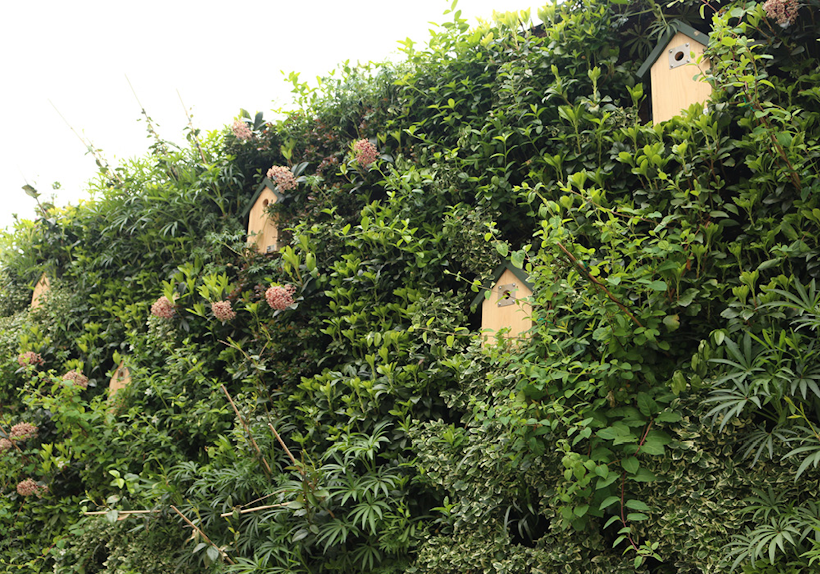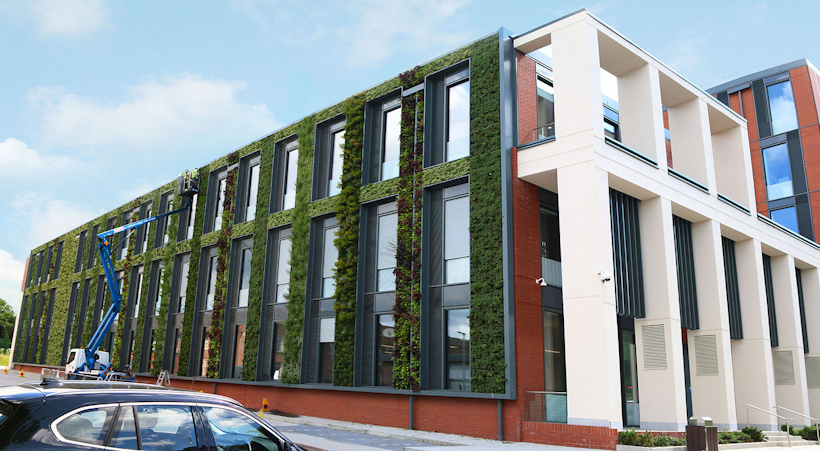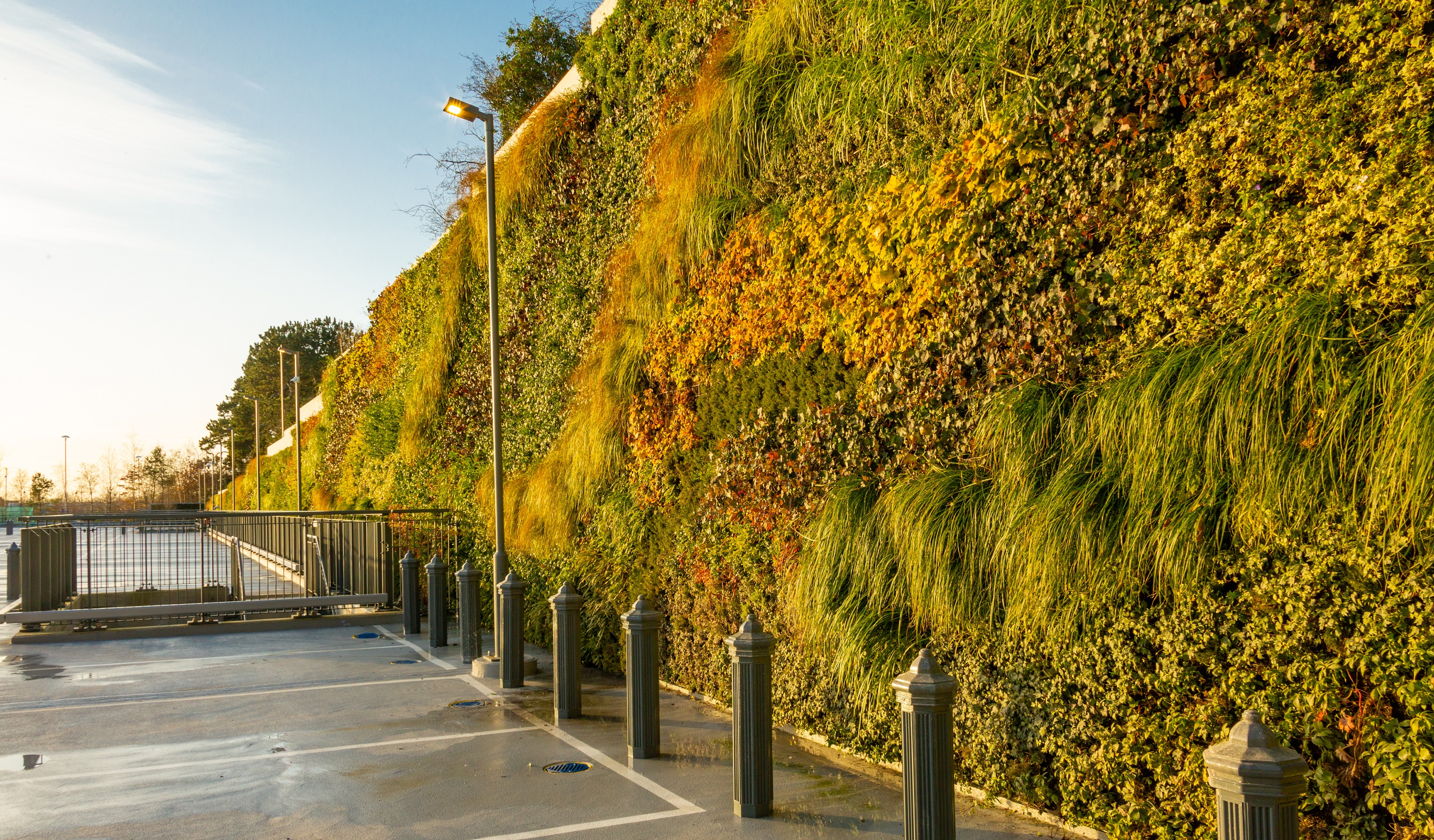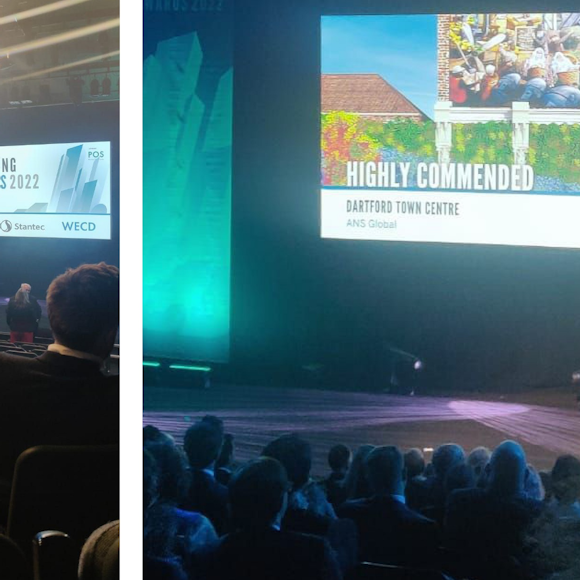Bringing nature into our urbanized cities is a vital component for a more sustainable future. More than ever, human connection to the natural world is becoming a rarity. Biophilic design is a new approach being adopted by architects to reintroduce nature into the urban fabric of our cities and towns. One way this is being achieved is through living walls. Living walls are self-sufficient vertical gardens that are attached to the exterior of a building. These walls are an innovative solution to re-greening the planet and re-connecting people with nature. In this article we will explore the benefits of biophilic design through living walls.
Exterior living walls encourage biodiversity
Biophilic design aims to reconnect human-beings with nature through biodiverse green infrastructure. Using a natural substrate means greater flexibility in plant selection, allowing for native species, pollinator planting and sources of nectar.
This creates a habitat for bees, burrowing insects and encourages natural colonisation. Watching wildlife at play further deepens our connection with nature and creates a pleasing space for us to relax and re-charge.
A 2014 PHD thesis by Caroline Chiquet which studied the biodiversity present in 22 living walls in the UK, found that birds were more present in residential areas with living walls than similar areas without living walls. In total, Chiquet found nine species of birds, 13 species of snails, 33 species of spiders and over 2600 morphospecies across the studied walls. Re-introducing biodiversity into cities and towns not only addresses the ecological crisis and the climate crisis, but also enhances our well-being.

Living walls purify the air
It is a well-known fact that poor air quality leads to numerous health issues. Biophilic design features that involve ‘nature in the space’ (one of the three biophilic design principles), such as living walls, act as a way to purify polluted air in urban cities. Living wall plants extract approximately 25% of toxins made by humans such as carbon dioxide from the air and convert it into oxygen - improving the surrounding air quality. This is not only beneficial to the health of the people living in the surrounding areas, but also for the overall health of the planet. With a living wall system based on natural soil, these benefits can be captured as the soil plays a key part in absorbing and filtering pollutants.
Exterior living walls reduce the ambient temperature
Plants absorb 50% of sunlight, resulting in a cooler, more pleasant and safer climate in built up cities. Exterior living walls influence the heat-island effect, reducing the average temperature of surrounding areas by 3 degrees. They also act as insulation helping to regulate a building’s temperature, keeping it warmer in Winter and cooler in Summer. A soil-based living wall on the exterior of a building has been shown to decrease the temperature of the buildings internal space by 16% in warm climates.
Living walls improve health and wellbeing
Biophilic design is based on the theory that human beings have an innate human instinct to connect with nature and other living beings in order to live healthy and happy lives. With a lack of green spaces in our cities, a decline in the wellbeing of those living in cities has become noticeable. According to a study, the risk of developing generalised anxiety disorder, is 21% higher in urban than rural dwellers. Living walls are an innovative way to incorporate greenery into a city that has minimal ground space. Having vertical gardens in cities has proven to boost the physical health of the people living in the area through improved air quality, and their mental wellbeing through reconnecting people to nature and its beauty. Good biophilic design combines a nature- and human-centric approach to create spaces that are inspirational and restorative for the community.

Living walls solve regulatory challenges
Living walls solve regulatory challenges and planning conditions by hitting environmental targets. Living walls also help to achieve building standards such as BREEAM and WELL. Some living walls can be designed to aid compliance with Biodiversity Net Gain (BNG), Urban Greening Factor (UGF) and working with a Circular Economy approach.

Living walls provide exterior structural protection
Protecting buildings from ultraviolet rays and acid rain is becoming an important factor for biophilic design. Many buildings are subjected to heavy rainfall, temperature changes, direct sunlight, and corrosive dust particles in the air. Living walls provide a natural answer to these considerations. The combination of plants and soil provide effective protection against rain and wind. When compared to cladding, paints and other building coatings which deteriorate, green walls can be an effective solution for the long-term sustainability of a structure.
Design a living wall with Viritopia and reap the benefits
Are you in the early stages of development? Are you looking to capitalise on environmental assets? Are you interested in learning more about living walls? Then look no further. Our team at Viritopia have you covered.
Using over 20 years’ experience designing and maintaining green infrastructure, we form detailed analysis on how a scheme is to meet regulation. We aid a faster planning process and provide you with what’s needed to take your project to the next level.
Get in touch with our expert team today or learn more about our living wall consultancy right here.

